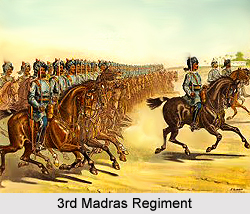 The 3rd Madras Regiment was an infantry regiment that formed after the restructuring and regrouping of the United Army of British India after the First World War. The unit remained in service from the year 1922 till 1947. Initially the unit was under the Madras Army, which was the armed forces of Madras Presidency and one of the three main Presidency Armies in British India. The Army of Madras Presidency was established with the purpose of protecting the commercial interests of the British East India Company. The British Presidency Armies were a part of the British East India Company until the Indian Rebellion of 1857. However in the year 1903, the 3 main presidency armies were merged together to form the United British Indian Army.
The 3rd Madras Regiment was an infantry regiment that formed after the restructuring and regrouping of the United Army of British India after the First World War. The unit remained in service from the year 1922 till 1947. Initially the unit was under the Madras Army, which was the armed forces of Madras Presidency and one of the three main Presidency Armies in British India. The Army of Madras Presidency was established with the purpose of protecting the commercial interests of the British East India Company. The British Presidency Armies were a part of the British East India Company until the Indian Rebellion of 1857. However in the year 1903, the 3 main presidency armies were merged together to form the United British Indian Army.
Following World War I reforms, the single battalion infantry regiments were converted in order to form multi battalion regiments comprising of 4 to 6 battalions in every regiment and also included a training battalion. The regiment was perpetually numbered the 10th and was eventually dissolved later for economical reasons. The 3rd battalion and the 4th battalion were disbanded in the year 1923, the 2nd battalion and 10th battalion were dissolved in 1926 and the 1st battalion in the year 1928.
The 3rd Madras Regiment was re-established in the year 1941 and restored to the Army List with the efforts of Sir Arthur Hope, who served as the Governor of Madras Presidency during that period. The former 11th Territorial battalion, 12th Territorial battalion, 13th Territorial battalion and 15th Territorial battalion were transformed into regular units. These units become the 1st to 4th battalions of the reconstituted Regiment. The Regimental Centre was constructed at Madukkarai (now Coimbatore). Eventually more battalions were developed and frantic training activities were started. The 4th Battalion of the 3rd Madras Regiment took part in the Imphal War in the year 1943 and provided valuable military services which resulted in Tamu in March 1944.
Captain R S Noronha was honoured with Military Cross for leading and defending his company for almost 16 days against recurrent attacks and inflicting grave casualties on the rival forces. Almost all of the Infantry Regiments of the British Indian Army, excluding Punjab, dropped the numbers of the units in October 1945. Consequently, the 3rd Madras Regiment was re-designated as simply The Madras Regiment. Moreover the Regimental Centre was moved to Trichinapally in the year 1946.
When the nation achieved independence from the rule of the British Empire in India in the year 1947, the 3rd Madras Regiment consisted of 4 battalions. These are mentioned below-
* 1st Battalion (formerly the 73rd Carnatic Infantry and 13th Madras Native Infantry)
* 2nd Battalion (formerly 75th Carnatic Infantry and 15th Madras Native Infantry)
* 3rd Battalion (formerly 79th Carnatic Infantry and 19th Madras Native Infantry)
* 4th Battalion (formerly 83rd Wallajahbad Light Infantry and 23rd Madras Native Infantry)
* 10th (Training) Battalion (formerly 86th Carnatic Infantry and 26th Madras Native Infantry)
After the country earned independence from the rule of the British Empire in India in the year 1947, the nation was divided by the occurrence of the Partition of India. As a result, 2 self-governing states were formed namely, the Union of India and the Dominion of Pakistan. The British Indian Army was divided amongst the 2 newly independent nations. The Madras Regiment was allocated to the modern Indian Army and serves as a line infantry regiment. At present the unit comprises of 20 Battalions. The 1st Battalion was integrated to the Mechanised Infantry Regiment.
At present, The Madras Regiment includes the following battalions-
* 2nd Battalion (formerly 75th Carnatic Infantry)
* 3rd Battalion (formerly 79th Carnatic Infantry)
* 4th Battalion (formerly 83rd Wallajahabad Light Infantry)
* 5th Battalion
* 6th Battalion
* 7th Battalion (Shandaar Saat Chamkte Rahe)
* 8th Battalion
* 9th Battalion Madras Regiment (formerly State Forces Unit)
* 10th Battalion
* 11th Battalion (formerly Territorial Battalion)(Double First)
* 12th Battalion (formerly Territorial Battalion)
* 16th Battalion (formerly State Forces Unit)
* 17th Battalion (formerly State Forces Unit)
* 18th Battalion (formerly Mysore Infantry)
* 19th Battalion
* 20th Battalion
* 25th Battalion (formerly Garrison Battalion)
* 26th Battalion (formerly Garrison Battalion)
* 27th Battalion (formerly Garrison Battalion)
* 28th Battalion (formerly Coastal Defence Battalion)



















